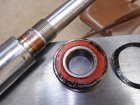You guys know I've just been turning a few months and I had a few projects that turned out pretty nice and I was happy learning to sharpen and tool technique. I noticed after I was allowed to start again after eye surgery more vibration in the lathe. I added more weight and adjusted the legs. I noticed tool marks in my bowls after what seemed to be a good cut. I checked the run out on the spindle and it didn't seem that bad. My wet bowl blanks after turning to round vibrated when I tried to go above 500 RPM. I read on here that the makeup of wet wood would sometime never become balanced so I had that thought also. On my next bowl the closer I got to the headstock I started getting tool bounce so I thought my gouge skills were off and I wasn't properly addressing the bevel of the gouge. The cause was finally revealed on a 3" x 12" maple round stock that I tried to make a finished cut on with a skew. Every time I made a cut the closer I got to the headstock the more my skew bounced and then I heard a clicking noise. I opened the door on the headstock and there was more than 1/16" runout on the indexing plate at the rear bearing. I sent the pictures to Laguna and they sent out a new spindle assembly and bearings the next day. They should arrive next Tuesday. I posted this as it may help someone with similar problems. The runout with no weight was amplified when a blank was mounted.


